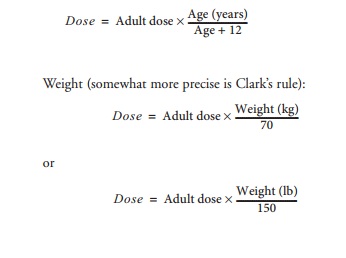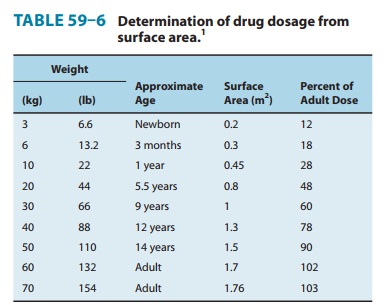Chapter: Basic & Clinical Pharmacology : Special Aspects of Perinatal & Pediatric Pharmacology
Pediatric Drug Dosage
PEDIATRIC DRUG DOSAGE
Because of differences
in pharmacokinetics in infants and chil-dren, simple proportionate reduction in
the adult dose may not be adequate to determine a safe and effective pediatric
dose. The most reliable pediatric dose information is usually that provided by
the manufacturer in the package insert. However, such infor-mation is not
available for the majority of products, even when studies have been published
in the medical literature, reflecting the reluctance of manufacturers to label
their products for chil-dren. Recently, the FDA has moved toward more explicit
expecta-tions that manufacturers test their new products in infants and
children. Still, most drugs in the common formularies, eg, Physicians’ Desk Reference, are not specifically approved for
chil-dren, in part because manufacturers often lack the economic incentive to
evaluate drugs for use in the pediatric market.
Most drugs approved
for use in children have recommended pediatric doses, generally stated as
milligrams per kilogram or per pound. In the absence of explicit pediatric dose
recommendations, an approximation can be made by any of several methods based
on age, weight, or surface area. These rules are not precise and should not be
used if the manufacturer provides a pediatric dose. When pediatric doses are
calculated (either from one of the meth-ods set forth below or from a
manufacturer’s dose), the pediatric dose should never exceed the adult dose.
With the current
epidemic of child obesity, a fresh and careful look at pediatric drug dosing
will be needed. Studies in adults indicate that dosing based on per kilogram of
body weight may constitute overdosing, because most drugs are distributed based
on lean body weight, rather than total (obese) weight.
Surface Area, Age, & Weight
Calculations of dosage
based on age or weight are con-servative
and tend to underestimate the required dose. Doses based on surface area (Table
59–6) are more likely to be adequate.
Age (Young’s rule):

In spite of these approximations, only by conducting studies in children can safe and effective doses for a given age group and condition be determined.

Related Topics